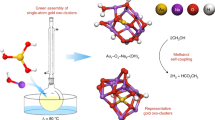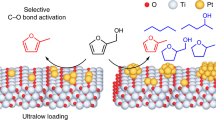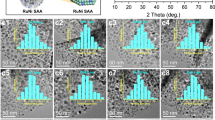Abstract
Metal-catalysed reactions are often hypothesized to proceed on bifunctional active sites, whereby colocalized reactive species facilitate distinct elementary steps in a catalytic cycle1,2,3,4,5,6,7,8. Bifunctional active sites have been established on homogeneous binuclear organometallic catalysts9,10,11. Empirical evidence exists for bifunctional active sites on supported metal catalysts, for example, at metal–oxide support interfaces2,6,7,12. However, elucidating bifunctional reaction mechanisms on supported metal catalysts is challenging due to the distribution of potential active-site structures, their dynamic reconstruction and required non-mean-field kinetic descriptions7,12,13. We overcome these limitations by synthesizing supported, atomically dispersed rhodium–tungsten oxide (Rh-WOx) pair site catalysts. The relative simplicity of the pair site structure and sufficient description by mean-field modelling enable correlation of the experimental kinetics with first principles-based microkinetic simulations. The Rh-WOx pair sites catalyse ethylene hydroformylation through a bifunctional mechanism involving Rh-assisted WOx reduction, transfer of ethylene from WOx to Rh and H2 dissociation at the Rh-WOx interface. The pair sites exhibited >95% selectivity at a product formation rate of 0.1 gpropanal cm−3 h−1 in gas-phase ethylene hydroformylation. Our results demonstrate that oxide-supported pair sites can enable bifunctional reaction mechanisms with high activity and selectivity for reactions that are performed in industry using homogeneous catalysts.
This is a preview of subscription content, access via your institution
Access options
Access Nature and 54 other Nature Portfolio journals
Get Nature+, our best-value online-access subscription
$29.99 / 30 days
cancel any time
Subscribe to this journal
Receive 51 print issues and online access
$199.00 per year
only $3.90 per issue
Buy this article
- Purchase on Springer Link
- Instant access to full article PDF
Prices may be subject to local taxes which are calculated during checkout




Similar content being viewed by others
Data availability
Source data associated with all theoretical and experimental analysis are provided with this paper. The data and code necessary to build the DFT-based microkinetic model that supports the plots in this paper are available on Zenodo at https://doi.org/10.5281/zenodo.6525676. Any other data in the supplementary information will be provided by the corresponding author upon request.
References
Cao, L. et al. Atomically dispersed iron hydroxide anchored on Pt for preferential oxidation of CO in H2. Nature 565, 631–635 (2019).
Saavedra, J. et al. The critical role of water at the gold-titania interface in catalytic CO oxidation. Science 345, 1599–1602 (2014).
Lam, E. et al. CO2 hydrogenation on Cu/Al2O3: role of the metal/support interface in driving activity and selectivity of a bifunctional catalyst. Angew. Chem. Int. Ed. 58, 13989–13996 (2019).
Shekhar, M. et al. Size and support effects for the water–gas shift catalysis over gold nanoparticles supported on model Al2O3 and TiO2. J. Am. Chem. Soc. 134, 4700–4708 (2012).
Carrasquillo-Flores, R. et al. Reverse water–gas shift on interfacial sites formed by deposition of oxidized molybdenum moieties onto gold nanoparticles. J. Am. Chem. Soc. 137, 10317–10325 (2015).
Kattel, S., Liu, P. & Chen, J. G. Tuning selectivity of CO2 hydrogenation reactions at the metal/oxide interface. J. Am. Chem. Soc. 139, 9739–9754 (2017).
Zhao, Z. J. et al. Importance of metal–oxide interfaces in heterogeneous catalysis: a combined DFT, microkinetic, and experimental study of water–gas shift on Au/MgO. J. Catal. 345, 157–169 (2017).
Blasco, T. et al. Carbonylation of methanol on metal-acid zeolites: evidence for a mechanism involving a multisite active center. Angew. Chem. Int. Ed. 46, 3938–3941 (2007).
Campos, J. Bimetallic cooperation across the periodic table. Nat. Rev. Chem. 4, 696–702 (2020).
Hetterscheid, D. G. H. et al. Binuclear cooperative catalysts for the hydrogenation and hydroformylation of olefins. ChemCatChem 5, 2785–2793 (2013).
Garland, M. The catalytic binuclear elimination reaction: importance of non-linear kinetic effects and increased synthetic efficiency. Top. Organomet. Chem. 59, 187–231 (2015).
Alexeev, O., Shelef, M. & Gates, B. C. MgO-supported platinum–tungsten catalysts prepared from organometallic precursors: platinum clusters isolated on dispersed tungsten. J. Catal. 164, 1–15 (1996).
Matsubu, J. C. et al. Adsorbate-mediated strong metal-support interactions in oxide-supported Rh catalysts. Nat. Chem. 9, 120–127 (2017).
Lwin, S. et al. Nature of WOx sites on SiO2 and their molecular structure–reactivity/selectivity relationships for propylene metathesis. ACS Catal. 6, 3061–3071 (2016).
Matsubu, J. C., Yang, V. N. & Christopher, P. Isolated metal active site concentration and stability control catalytic CO2 reduction selectivity. J. Am. Chem. Soc. 137, 3076–3084 (2015).
Sparta, M., Børve, K. J. & Jensen, V. R. Activity of rhodium-catalyzed hydroformylation: added insight and predictions from theory. J. Am. Chem. Soc. 129, 8487–8499 (2007).
Li, C., Wang, W., Yan, L. & Ding, Y. A mini review on strategies for heterogenization of rhodium-based hydroformylation catalysts. Front. Chem. Sci. Eng. 12, 113–123 (2018).
Mol, J. C. Industrial applications of olefin metathesis. J. Mol. Catal. A 213, 39–45 (2004).
Ross-Medgaarden, E. I. & Wachs, I. E. Structural determination of bulk and surface tungsten oxides with UV–vis diffuse reflectance spectroscopy and raman spectroscopy. J. Phys. Chem. C 111, 15089–15099 (2007).
Barton, D. G. et al. Structure and electronic properties of solid acids based on tungsten oxide nanostructures. J. Phys. Chem. B 103, 630–640 (1999).
Ro, I. et al. Synthesis of heteroatom Rh-ReOx atomically dispersed species on Al2O3 and their tunable catalytic reactivity in ethylene hydroformylation. ACS Catal. 9, 10899–10912 (2019).
Rice, C. A. et al. The oxidation state of dispersed Rh on Al2O3. J. Chem. Phys. 74, 6487–6497 (1981).
Lee, S. et al. Theoretical study of ethylene hydroformylation on atomically dispersed Rh/Al2O3 catalysts: reaction mechanism and influence of ReOx promoter. ACS Catal. 11, 9506–9518 (2021).
Perez-Aguilar, J. E. et al. Isostructural atomically dispersed rhodium catalysts supported on SAPO-37 and on HY zeolite. J. Am. Chem. Soc. 142, 11474–11485 (2020).
Brundage, M. A. & Chuang, S. S. C. Experimental and modeling study of hydrogenation using deuterium step transient response during ethylene hydroformylation. J. Catal. 164, 94–108 (1996).
Lange, J. P. Performance metrics for sustainable catalysis in industry. Nat. Catal. 4, 186–192 (2021).
Digne, M. et al. Hydroxyl groups on γ-alumina surfaces: a DFT study. J. Catal. 211, 1–5 (2002).
Navidi, N., Thybaut, J. W. & Marin, G. B. Experimental investigation of ethylene hydroformylation to propanal on Rh and Co based catalysts. Appl. Catal. A 469, 357–366 (2014).
Shylesh, S. et al. In situ formation of Wilkinson-type hydroformylation catalysts: insights into the structure, stability, and kinetics of triphenylphosphine- and xantphos-modified Rh/SiO2. ACS Catal. 3, 348–357 (2013).
Whittaker, T. et al. H2 oxidation over supported Au nanoparticle catalysts: evidence for heterolytic H2 activation at the metal–support interface. J. Am. Chem. Soc. 140, 16469–16487 (2018).
Baz, A. & Holewinski, A. Understanding the interplay of bifunctional and electronic effects: microkinetic modeling of the CO electro-oxidation reaction. J. Catal. 384, 1–13 (2020).
Darby, M. T. et al. Lonely atoms with special gifts: breaking linear scaling relationships in heterogeneous catalysis with single-atom alloys. J. Phys. Chem. Lett. 9, 5636–5646 (2018).
Andersen, M. et al. Analyzing the case for bifunctional catalysis. Angew. Chem. Int. Ed. 55, 5210–5214 (2016).
Kumar, G. et al. Multicomponent catalysts: limitations and prospects. ACS Catal. 8, 3202–3208 (2018).
Qi, J. et al. Selective methanol carbonylation to acetic acid on heterogeneous atomically dispersed ReO4/SiO2 catalysts. J. Am. Chem. Soc. 142, 14178–14189 (2020).
Hoffman, A. J. et al. Theoretical and experimental characterization of adsorbed CO and NO on γ-Al2O3-supported Rh nanoparticles. J. Phys. Chem. C 125, 19733–19755 (2021).
Sirita, J., Phanichphant, S. & Meunier, F. C. Quantitative analysis of adsorbate concentrations by diffuse reflectance FT-IR. Anal. Chem. 79, 3912–3918 (2007).
Lwin, S. et al. Surface ReOx sites on Al2O3 and their molecular structure–reactivity relationships for olefin metathesis. ACS Catal. 5, 1432–1444 (2015).
Chupas, P. J. et al. A versatile sample-environment cell for non-ambient X-ray scattering experiments. J. Appl. Crystallogr. 41, 822–824 (2008).
Ravel, B. & Newville, M. ATHENA, ARTEMIS, HEPHAESTUS: data analysis for X-ray absorption spectroscopy using IFEFFIT. J. Synchrotron Radiat. 12, 537–541 (2005).
Ro, I. et al. The role of Pt-FexOy interfacial sites for CO oxidation. J. Catal. 358, 19–26 (2018).
Perdew, J. P., Burke, K. & Ernzerhof, M. Generalized gradient approximation made simple. Phys. Rev. Lett. 77, 3865–3868 (1996).
Grimme, S., Antony, J., Ehrlich, S. & Krieg, H. A consistent and accurate ab initio parametrization of density functional dispersion correction (DFT-D) for the 94 elements H–Pu. J. Chem. Phys. 132, 154104 (2010).
Kresse, G. & Furthmüller, J. Efficiency of ab-initio total energy calculations for metals and semiconductors using a plane-wave basis set. Comput. Mater. Sci. 6, 15–50 (1996).
Blöchl, P. E. Projector augmented-wave method. Phys. Rev. B 50, 17953–17979 (1994).
Sheppard, D., Terrell, R. & Henkelman, G. Optimization methods for finding minimum energy paths. J. Chem. Phys. 128, 134106 (2008).
Sheppard, D. et al. A generalized solid-state nudged elastic band method. J. Chem. Phys. 136, 074103 (2012).
Coltrin, M. E., Kee, R. J., Rupley, F. M. & Meeks, E. SURFACE CHEMKIN-III: A Fortran Package for Analyzing Heterogeneous Chemical Kinetics at a Solid-surface–Gas-phase Interface Report SAND96-8217 (Sandia, 1996).
Lym, J., Wittreich, G. R. & Vlachos, D. G. A Python multiscale thermochemistry toolbox (pMuTT) for thermochemical and kinetic parameter estimation. Comput. Phys. Commun. 247, 106864 (2020).
Acknowledgements
I.R., J.Q., S.L., D.G.V., S.C. and P.C. acknowledge the Catalysis Center for Energy Innovation, an Energy Frontier Research Center funded by the US Department of Energy, Office of Science, Office of Basic Energy Sciences under award number DE-SC0001004. M.X., X.Y. and X.P. acknowledges the NSF awards under grant nos CBET-2031494 and CHE-1955786 for support for the microscopy. This research used 7-BM (QAS) beamline of the National Synchrotron Light Source II, a US DOE Office of Science User Facility operated for the DOE Office of Science by Brookhaven National Laboratory under contract no. DE-SC0012704. Beamline operations were supported in part by the Synchrotron Catalysis Consortium (US DOE, Office of Basic Energy Sciences, grant no. DE-SC0012335). I.R. acknowledges the National Research Foundation of Korea (NRF) grant funded by The Ministry of Science and ICT (MSIT) (NRF-2021R1F1A1054980). The authors acknowledge the use of facilities and instrumentation at the UC Irvine Materials Research Institute (IMRI) supported in part by the NSF through the MRSEC program (DMR-2011967). We acknowledge A. B. Getsoian for providing the 10% Rh/Al2O3 Rh nanoparticle control sample. J. Resasco is acknowledged for his comments on the paper.
Author information
Authors and Affiliations
Contributions
I.R. and J.Q. synthesized, characterized and evaluated the reactivity of all catalysts. S.L. executed all theoretical analyses. M.X. and X.Y. performed all microscopy. Z.X. performed XAS measurements and associated data analysis. G.Z. designed and built the high-pressure reactor. A.M. helped develop catalyst synthesis methodologies. J.G.C. oversaw the XAS measurements and analysis. X.P. oversaw the microscopy and analysis. D.G.V. and S.C. oversaw the theoretical calculations and analysis. P.C. conceived and managed the overall project. All authors contributed to writing the manuscript.
Corresponding author
Ethics declarations
Competing interests
The authors declare no competing interests.
Peer review information
Peer review information
Nature thanks Tiefeng Wang and Mie Andersen for their contribution to the peer review of this work.
Additional information
Publisher’s note Springer Nature remains neutral with regard to jurisdictional claims in published maps and institutional affiliations.
Supplementary information
Rights and permissions
Springer Nature or its licensor holds exclusive rights to this article under a publishing agreement with the author(s) or other rightsholder(s); author self-archiving of the accepted manuscript version of this article is solely governed by the terms of such publishing agreement and applicable law.
About this article
Cite this article
Ro, I., Qi, J., Lee, S. et al. Bifunctional hydroformylation on heterogeneous Rh-WOx pair site catalysts. Nature 609, 287–292 (2022). https://doi.org/10.1038/s41586-022-05075-4
Received:
Accepted:
Published:
Issue Date:
DOI: https://doi.org/10.1038/s41586-022-05075-4
This article is cited by
-
Electrochemistry-inspired design of thermocatalysts
Nature Catalysis (2024)
-
Heterocatalytic ethylene methoxycarbonylation via a pseudo-hydride pathway over Pt1/MoS2
Science China Chemistry (2024)
-
Atomically dispersed materials: Ideal catalysts in atomic era
Nano Research (2024)
-
Atomically synergistic Zn-Cr catalyst for iso-stoichiometric co-conversion of ethane and CO2 to ethylene and CO
Nature Communications (2024)
-
Identifying and avoiding dead ends in the characterization of heterogeneous catalysts at the gas–solid interface
Nature Catalysis (2023)
Comments
By submitting a comment you agree to abide by our Terms and Community Guidelines. If you find something abusive or that does not comply with our terms or guidelines please flag it as inappropriate.



